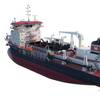High Correlation of Biomass to Species Diversity in Northern Chukchi Sea - BOEM Study
Last summer, researchers began a five year study to monitor biodiversity in the Arctic Chukchi Sea from an ecosystem perspective, looking at microbes, whales and everything in between. Marine biodiversity is a key indicator of ocean
health and critical ecosystem services that contribute to human life. Monitoring it improves our ability to interpret and forecast changes. The unprecedented effects of climate change combined with strong seasonal cycles and increasing human activities in the Arctic make this region particularly important to monitor.
In August 2015, the AMBON team of researchers from the University of Alaska’s School of Fisheries and Ocean Sciences, the University of Maryland, University of Washington, US Fish and Wildlife Service, and the National Oceanic and Atmospheric Administration (NOAA) embarked on their first field effort under this project to sample marine biodiversity on the Chukchi Sea shelf. Despite challenging weather conditions, the team was able to complete sampling of the entire Chukchi shelf from south to north and across the shelf from nearshore to more than 150 miles (250 km) offshore. The Bureau of Ocean Energy Management (BOEM) is supporting this study to enhance environmental impact assessments and develop better metrics for cumulative impact
analysis and a broader perspective of the ecosystem.
Initial results of the AMBON field effort have been successful in sampling important ecosystem components across species and regions and in detecting important patterns of ecosystem function. The AMBON is one of three U.S. demonstration projects helping to develop a Marine Biodiversity Observing Network (MBON) for the nation.
Year 1 findings on the water column, the sea floor, marine mammals and seabirds include:
Water column:
o Physical measurements of the water column established warmer waters flowing northward along the Alaskan coast, associated with the Alaska Coastal Current, although researchers did not observe the expected corresponding low salinity of this water mass.
o Water column chlorophyll was particularly high in the southern and northern offshore study regions, with lesser concentration in the middle region. These chlorophyll water column patterns were reflected in sediment chlorophyll, confirming the tight relationship between the pelagic and the benthic systems from the sinking of phytoplankton production to the seafloor.
Seafloor:
o There were strong gradients in biomass and diversity of epifauna invertebrates (organisms living on top of the seafloor, such as crabs, sea stars and snails). Gradients mean that there were changes in the values measured such as species abundance and relevant physical parameters such as pressure and temperature that drive biomass and diversity. Both biomass and species diversity were much higher in the northern than the southern Chukchi Sea, indicating a very weak relationship of the epifauna with chlorophyll, which is commonly used as a measure of food availability. This is different from known macro-infaunal patterns, organisms living within the sediment such as clams and tube worms, which are very strongly tied to chlorophyll distribution. For example, sediment chlorophyll values peak in regions that also are known as macro-infauna hotspots in the southern Chukchi Sea.
o Bottom fish were generally small in size but at times very abundant, and bottom fish and epibenthic invertebrates, which live on the sea floor, showed some overlap in distribution patterns.
o The AMBON cruise was extremely successful in collecting approximately 80% of the expected species diversity of epifauna (about 290 of an expected 350 species) and nearly 90% of expected richness of bottom fish (28 of approximately 32 expected species), reflecting the success of the sampling design used in the project for monitoring these ecosystem components.
Marine mammals:
o Pacific walrus in particular were most common in the northern study region, in part coinciding with high biomass of benthic invertebrates that serve as food sources for these bottom-feeding mammals.
o As sea ice in the Chukchi Sea is more and more diminished, walrus cannot use it any longer as a resting platform between feeding bouts; they have become more tied to the land for haul-out, and thus to the benthic food resources closer to shore.
o The ecosystem-wide sampling from AMBON provides an unprecedented high coverage dataset to study the associations between walrus and their food resources under these new ice-free scenarios.
Seabirds
o A variety of seabirds, including some common species such as phalaropes and shearwaters and some rare species such as dovekies, were observed during the AMBON cruise, with highest overall densities in the southern-most and northern-most regions. Shearwaters feed on fish and zooplankton and forage both at the surface and underwater. They were most abundant near Barrow Canyon, an area where physical processes concentrate prey in the water column, thus attracting an abundance of marine birds and mammals.
o Similarly, surface-feeding marine birds that include gulls, terns, and phalaropes, were concentrated around Barrow Canyon, close to Pt. Barrow. Least auklets and murres were abundant in areas of strong currents and high productivity, while benthic-feeding marine birds, such as eiders, occurred primarily nearshore.
AMBON is sponsored under the National Oceanographic Partnership Program (NOPP) with support from BOEM, NOAA, and Shell Oil Company. The sponsors aim to develop good practices for a biodiversity network that can be translated to other regions and ecosystems. Beyond the Chukchi Sea, AMBON will network across the pan-Arctic and on a global scale with other biodiversity observing networks. The project also will integrate with past and ongoing research programs on the U.S. Arctic shelf to develop an Arctic biodiversity observation network of shared information and open data access. The study is expected to run until 2019, with the next field season occurring in 2017. Future research will include data collection from NASA and NOAA satellites. Additional information is available on this poster and the NOAA/IOOS page.
The project aligns with the U.S. Arctic Strategy, complements growing interest in the Arctic, and is one of more than 550
environmental studies BOEM has supported on the Alaska Outer Continental Shelf since 1973.










